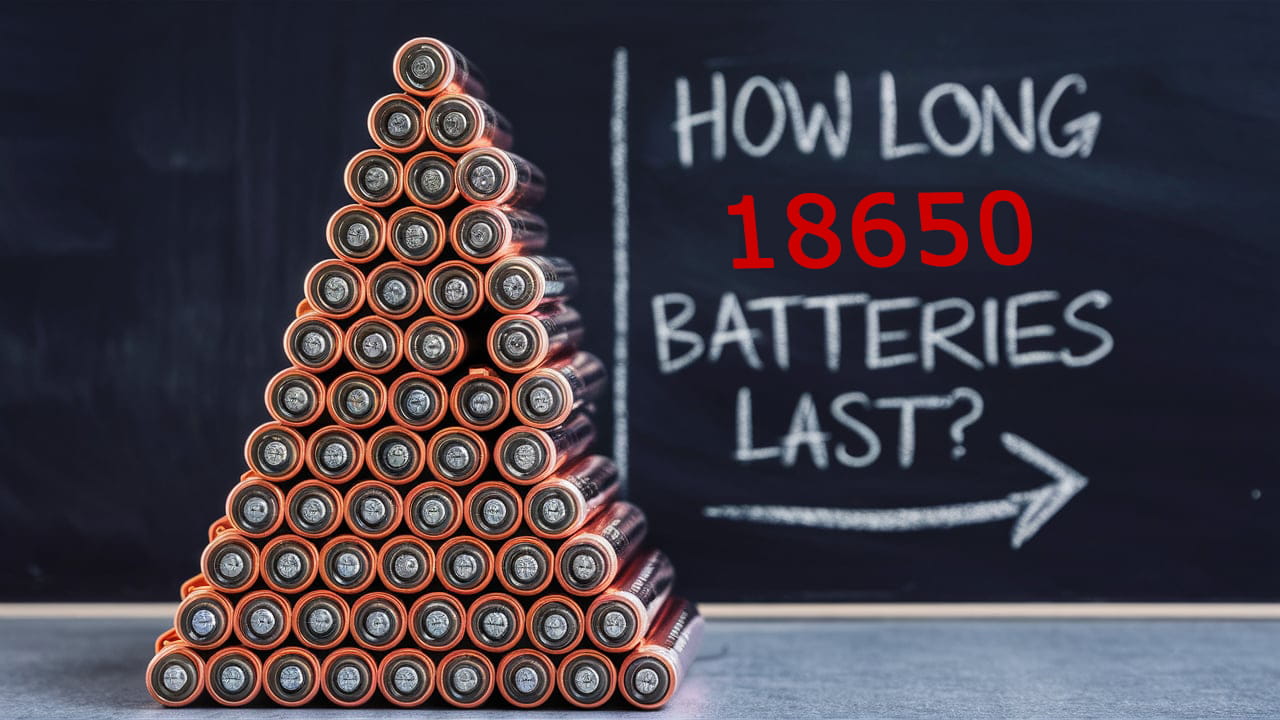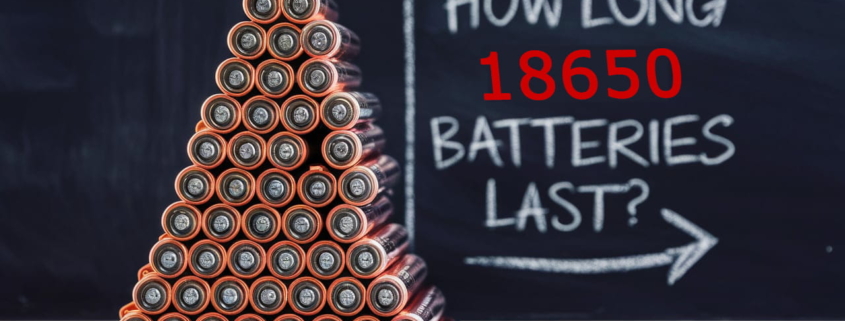How Long Do 18650 Batteries Last? The Complete Lifespan Guide (2024 Updated)
18650 batteries have become massively popular over the last few years. You can find these lithium-ion cells powering vapes, flashlights, power tools, and even electric vehicles. I mean, 18650 batteries are everywhere these days.
But if you use devices powered by 18650s, I’m sure you’ve wondered: “How long do 18650 batteries actually last?”
Great question, as a professional 18650 battery packs manufacturer, I will help you find it out. The answer depends a lot on how you use, charge, and store your 18650s.
Follow the tips in this guide and your batteries will last for years. Ignore them? Your 18650s will be useless chunks of metal and chemicals in no time.
Let’s start with the basics.

What Is a 18650 Battery?
First, what the heck does “18650” mean?
Here’s a quick breakdown:
“18650” refers to the size of the cylindrical lithium-ion battery:
- 18mm diameter
- 65mm tall
- 0 prefix before the diameter indicates it’s a cylinder
So 18650 isn’t a specific battery chemistry. Instead, it tells you the dimensions of the cell.
(You’ll also see bigger 21700 and smaller 14500 batteries)
Now, within the 18650 size class you’ll find various lithium-ion battery chemistries, including:
- LiCoO2 (lithium cobalt oxide): The most common. Gives high capacity but shorter lifespan. Used when size and weight are key.
- LiMn2O4 (lithium manganese oxide): Low capacity but a long lifespan. Handles high discharge better. Used in power tools.
- LiNiMnCoO2 (NMC): Balances lifespan and capacity. The most used chemistry by Tesla.
- LiFePO4 (lithium iron phosphate): Lowest capacity but longest lasting. Safest chemistry. Used when safety is critical.
Each chemistry has pros and cons. But they all provide high energy density, low self-discharge, and no memory effect.
So how long do these various 18650 chemistries actually last?
How Long Should An 18650 Battery Last?
The lifespan of an 18650 battery depends mainly on:
- Charge/discharge cycles: Fully charging then fully discharging the cell. After 300-500 cycles 18650s degrade.
- Shelf life: How long cells last in storage before degrading. 18650s can last 10+ years if stored properly.
- Regular use: Steady charging/discharging degrades batteries faster than infrequent use.
Based on those factors, here is how long you can expect your 18650 batteries to last:
Charge/Discharge Cycles
Lithium-ion batteries slowly lose capacity through charge/discharge cycles.
Eventually they’ll drop below 80% of original capacity. This makes the cells pretty much useless.
Most high-quality 18650s are rated for 300-500 full charge/discharge cycles.
Low-quality no-name cells may rate even less. Quality lithium phosphate 18650s boast 500-2000 cycles.
Shelf Life
Even unused, batteries slowly “decay” internally over time, reducing capacity.
Top-tier cells stored properly at low temperatures can retain ~80% capacity for 10+ years.
Lesser quality cells may lose 20% capacity per year when stored.
Regular Use
Using 18650 batteries wears them out through repeated charging and discharging.
With regular use expect 12-24 months from vape batteries, 2-4 years from power tool batteries.
Overall quality lithium cells should still meet 80% capacity after ~5 years of average use.
Tips To Extend The Lifespan Of 18650 Batteries
Now let’s get into some tips and tricks to stretch the life of your 18650 lithium-ion batteries:
1. Buy Quality 18650 Cells
As with most products, better quality batteries last longer.
Cells from top battery brands (LG, Sony, Samsung, Panasonic) typically offer 300-500+ cycles.
Lesser brands may rate only 150-300 cycles before dropping to 80% capacity.
2. Use The Right Charger
A quality 18650 battery charger is important to maximize cell lifespan.
Look for corrosion-resistant materials and precise charging termination. This protects cells from overcharging damage.
Charging multiple cells? The best 18650 chargers individually charge each cell. This prevents issues from battery mismatches.
3. Don’t Discharge Too Low
Never discharge 18650s below 2.5 volts. The lower the discharge, the more damage.
Li-ion battery management systems prevent excess discharge. Without this cells discharge until dead (aka “brick”).
Lithium battery protection circuits cut off discharge around 2.5-3 volts. This prevents damage from deep discharge while retaining capacity.
4. Reduce Charge/Discharge Rates
Charging or discharging at lower amperage rates is gentler on cells.
Shoot for 0.5-1C (1C = cell capacity). This preserves capacity over hundreds more cycles than max current draws.
5. Don’t Store At Full Or Zero Charge
Storing 18650s fully charged or fully dead degrades their lifespan.
Best practice is 40-60% charge capacity for storage. This minimizes aging effects.
Every 6-12 months, charge cells to ~60% capacity to replenish lost performance. Then discharge to 40% and return to storage.
6. Store Batteries Properly
Capacity fades faster in high heat or varying temperatures.
Store cells around 25 ̊C and <60% humidity. Fridge temperatures (2-10 ̊C) also work but may lead to moisture issues.
Individual plastic battery cases prevent contact damage during storage.
When Is It Time To Replace Your 18650 Battery?
With repeated charging, discharging, and aging your 18650 battery capacity will drop.
When your cell falls below 80% original capacity, it’s basically at end of useful life. Time for a new battery.
But how do you know when 80% capacity is reached?
Watch for these signs your 18650 is wearing out:
- Runtime dropping substantially
- Longer charging times
- Overheating during charge or discharge
- Visible damage (leaks, swelling, etc)
- Unstable voltage readings
- 10%+ loss of capacity per year
When you notice several degradation signs it’s definitely time to retire that 18650 to the battery recycling bin.
If your application demands maximum battery capacity (like vaping), replace cells annually. For low-drain uses (remote controls), every 2-3 years is fine.
Top Tips To Safely Handle 18650 Batteries
Mishandling lithium-ion batteries can literally set your device ablaze. Yikes!
Follow these tips when handling 18650 cells:
- No loose batteries: Always secure cells in a holder or device
- Use protective cases: Never let metal objects contact batteries
- Check insulating wraps: Replace damaged battery wraps immediately
- Mind polarity: Insert cells properly aligned positive-to-negative
- Don’t overheat: Stop charging if batteries get hot
- Don’t crush or puncture: Damaged lithium batteries can combust!
Key Takeaways: Maximizing Your 18650 Battery Lifespan
Getting the most lifespan out of lithium-ion 18650 batteries requires:
- Buying quality cells from reputable brands
- Using the proper chargers and not exceeding charge/discharge ratings
- Storing around 50% charge capacity at moderate temperatures
- Retiring cells when capacity drops below 80%
- And battery safety handling should always be priority #1
Follow those tips and your 18650 vape batteries, power tool battery packs, and other Li-ion cells should deliver years of runtime.
I hope this guide gave you a better idea of real-world lithium battery lifespan. Now you know exactly how long 18650 batteries last!
Let me know if you have any other battery lifespan questions.








